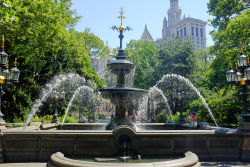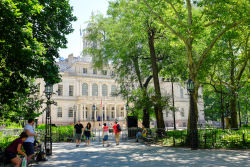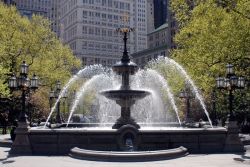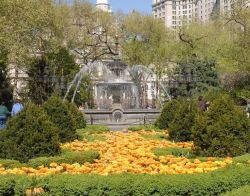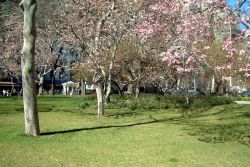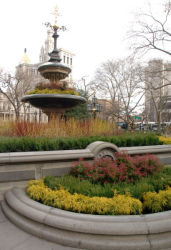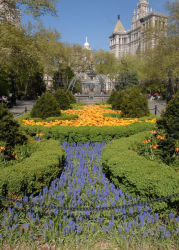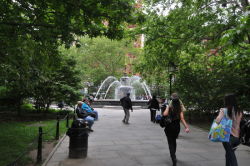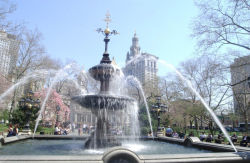City Hall Park
The Daily Plant : Thursday, September 21, 2006
1776: Famous Last Words?

Credit: Simon Benepe / New York City Parks Photo Archive
Good students of history can quote Nathan Hale’s last words: “I only regret that I have but one life to lose for my country.” Better students of history know that these words were never uttered. Many people – students or otherwise – also falsely believe that Hale was hanged in what is now City Hall Park. This assumption owes largely to the fact that his memorial statue stands there.
In keeping with this column’s mission, we will present the facts of this matter. Most fundamentally, history assures us that if you went back in time to New York 230 years ago today, you would find Nathan Hale working as a spy. And if you were to go back 230 years ago tomorrow, you would find Nathan Hale dead.
Young Hale, a 21-year-old captain from Connecticut, had been on a spy mission for General Washington on Long Island (i.e. Brooklyn / Queens). Disguised as a Dutch schoolteacher, Hale attempted to infiltrate New York’s British ranks to gather intelligence on the enemy’s Long Island military installations. The young man was captured, however, on the night of September 21, 1776, and brought to General William Howe’s quarters in Manhattan, which history tells us stood roughly in the East 40s. The general interrogated the prisoner, Hale confessed, and Howe ordered him hanged the next morning without a trial.
Lieutenant Frederick MacKenzie of the Royal Welsh Fusileers recorded in his diary that Hale was hanged “at 11 o’clock in front of the Park of Artillery.” William Kelby, a librarian working at the New York Historical Society in the 1890s, determined that the British artillery was massed at the highest point south of Harlem on the Post Road (a key colonial route largely eliminated in Manhattan by the grid plan). The nearest modern-day intersection for this location is Third Avenue and East 66th Street. In other words, this spot was about five miles north of the settled city at that time, and therefore just as far from City Hall Park.
As for the famous quote, an American officer reported years later that he heard them a few hours after the hanging from a British officer who was present. Regardless of their historic faithfulness, that famous quote certainly reflects Hale’s sentiment and bravery at the moment of his death. Lieutenant MacKenzie’s diary describes the scene: “He behaved with great composure and resolution…”
Academically speaking, the veracity of the quote almost does not matter. In the greater scope of history, Hale is a symbol of the American Revolution, like George Washington’s white horse, which was actually gray, and the Battle of Bunker Hill, which took place on Breed’s Hill.
Oftentimes, the myths and symbols of history have their root in some work of art. In this case the artist is Frederick Macmonnies (1863-1937) whose Nathan Hale has stood in City Hall Park since 1893. Since no life portraits of the patriot spy exist, the bronze statue offers a romantic interpretation of Hale shackled and bound on the morning of his execution.
Written by John Mattera
QUOTATION FOR THE DAY
“Most of the trouble in the world is caused by people wanting to be important.”
T.S. Eliot
(1888-1965)
Check out your park's Vital Signs
Clean & Safe
Green & Resilient
Empowered & Engaged Users
Share your feedback or learn more about how this park is part of a
Vital Park System

